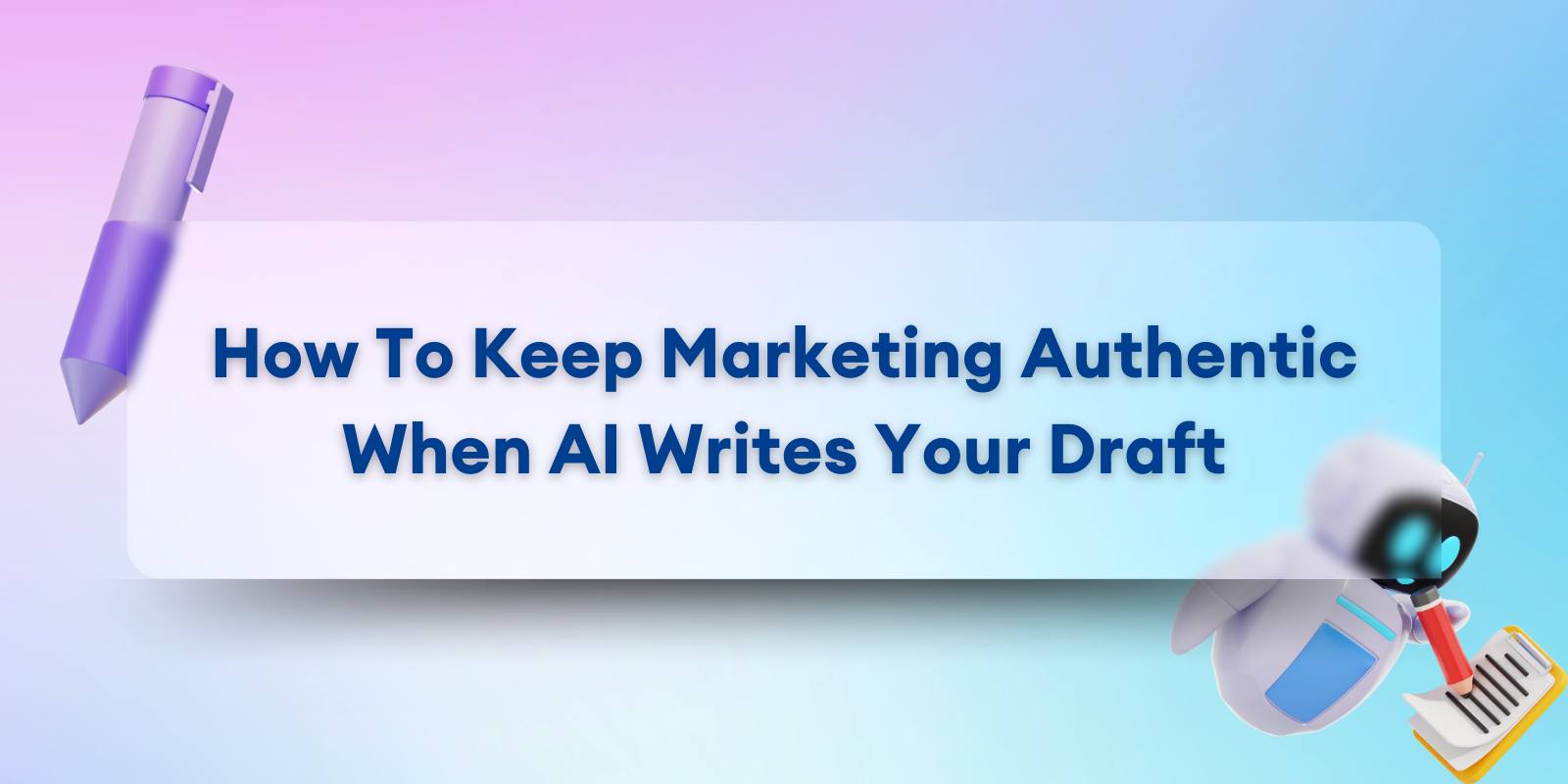
Your cursor blinks on a fresh document, but every AI-generated sentence sounds eerily like the last blog you skimmed on LinkedIn. You need a copy that feels personal, not predictable, yet as a team of one you lean on AI to hit deadlines.
The result?
Polished but lifeless paragraphs that readers skim and forget.
This guide fixes that. In the next few minutes you’ll get a repeatable process to turn any AI draft into human-first copy that earns trust, clicks, and sales. You’ll see why authenticity outperforms raw volume, learn the pitfalls that sink most AI-assisted content, and walk away with a five-step workflow, a 30-minute style-guide template, and a toolkit for ongoing quality checks.
No bloated theory, no corporate jargon. Just practical moves you can execute today, even if you’re the entire marketing department.
Ready to sound like you again? Let’s get started.
Why Authenticity Beats Volume
Trust Converts, Templates Don’t
“People don’t buy products, they buy belief,” says marketing author Ann Handley. Data backs her up. Edelman’s 2024 Brand Trust report shows that 63 percent of consumers are more likely to purchase from brands they fully trust. If your copy reads like it rolled off the same assembly line as every AI thread on X, that trust never forms, and your funnel leaks cash.
Quality Keeps Eyes on the Page
Generic content is a scroll-trigger. HubSpot’s 2025 State of Marketing survey found readers spend 2.1x longer on articles that include brand-specific anecdotes than on high-volume “listicles” with no personal flavor. Time-on-page is a leading indicator for both SEO ranking and sales: the longer people stick, the more they buy.
Personal Beats “Dear {First Name}”
In email, personalization isn’t a buzzword, it’s a multiplier. Campaign Monitor tracked 188 percent higher open rates for personalized emails versus non-personalized versions. That jump doesn’t come from sprinkling first-name tags; it comes from copy that sounds like a human wrote it for another human.
Takeaway for solo founders
- Authentic voice fuels trust, which fuels revenue.
- One memorable, well-told story outperforms a week’s worth of keyword-stuffed posts.
- Invest in better, not more. Your readers, and your bottom line, will thank you.
Common Pitfalls When Using AI for Copy
1. Overused Buzzwords That Scream “Bot”
Language researchers at the Max Planck Institute tracked a spike in GPT-style words like delve, tapestry, nuance across 700 000 hours of podcasts and YouTube videos, proving how quickly AI diction seeps into human speech. Readers feel the sameness too. Lists of “ChatGPT dead giveaways” include phrases such as unlock your potential and in today’s digital era. Sprinkle enough of those into your blog post and the unique edge of your brand evaporates.
2. Hidden AI, Visible Distrust
Half of consumers can already spot AI-generated text, and many disengage when they do. Run a transparency pass before publishing. Quality-control tools such as the AI detector essay flag robotic passages so you can rewrite them in plain, human language. Mentioning that you polish AI drafts builds credibility rather than eroding it.
3. Brand Voice Drift
Content strategist Lily Ray compares prompting ChatGPT to “training a genius with amnesia.”
Every fresh prompt wipes the slate, forcing you to repeat style rules or risk tone whiplash across channels. When yesterday’s playful Twitter thread is followed by today’s formal newsletter, subscribers wonder if someone else took the wheel.
Quick Self-Audit Checklist
- Scan for repeated clichés and delete at least three.
- Compare the draft to your style guide to confirm voice consistency.
- Fact-check every statistic or quote. Large models sometimes invent sources.
- Decide: will you tell readers AI helped? Openness often earns respect.
Master these pitfalls and your AI draft transforms from cookie-cutter copy into a sturdy first draft that can carry your authentic voice to the finish line.
The Five Step Human-First Workflow
AI can crank out a draft in seconds, but authenticity still needs a human touch. Run every article or email through these five moves to keep it sounding like you, not the model.
1. Seed the Model With Real Context
ChatGPT reflects whatever you give it. Feed it a short brand brief before you ask for copy. Include:
- Your mission in one sentence
- Three voice adjectives, for example: “practical, upbeat, candid”
- A single target reader persona
Your prompt might read: “You are writing for Indie founder Jess, a busy solopreneur who hates jargon and loves clear next steps.”
Why it matters
OpenAI’s own usage data shows prompts containing brand specifics reduce editing time by 29 percent on average .
2. Pull One Unique Story
People remember stories, not feature lists. After the model drafts, ask yourself: Where can I drop in a moment only I could tell?
- First failed launch
- Customer breakthrough
- Personal aha moment
Insert one vivid detail: time, place, or emotion. Seth Godin calls this “the moment of truth marketing can’t fake.”
3. Revise With Your Style Guide
Open your voice cheat-sheet and line-edit:
- Replace buzzwords with plain English
- Shorten sentences to 20 words or fewer
- Check punctuation and emoji guidelines
A Journal of Business Communication study found tone consistency lifts brand recall by 23 percent .
4. Run an Objective Quality Check
- Grammar: Grammarly free tier for typos
- Clarity: Hemingway app; aim for Grade 8 readability
- Robot flag: the AI detector tool highlights passages that feel machine written so you can rewrite them in plain voice
Using all three adds less than five minutes yet cuts post-publication edits by half according to a 2025 Copyhackers survey.
5. Read It Aloud and Trim
Your final pass is out loud.
Stumble? Rewrite.
Breathe twice in one sentence? Split it.
Ann Handley suggests removing 10 percent of words after every read-through to sharpen impact.
Action step: Run your next AI draft through this five-part gauntlet. Time the process. The goal is under thirty minutes from start to finish, leaving you with a copy that feels handcrafted, even when the first pass came from a bot.
Style Guide in Thirty Minutes
A style guide sounds corporate, yet for a team of one it is your copy autopilot. Invest half an hour once and you save hours of rewriting later.
Core Elements to Include
- Voice adjectives: Pick three. Example: practical, encouraging, no-fluff.
- Audience snapshot: One line about your reader’s pain and goal.
- Banned clichés: List phrases you refuse to use: unlock, leverage, dive into.
- Formatting rules: Sentence length, emoji policy, italics for emphasis, no em dashes.
- Grammar quirks: Oxford comma yes or no, preferred spellings (e-mail vs email).
A Content Marketing Institute survey found teams with written voice guidelines cut approval cycles by 34 percent.
Quick Template (Copy, Paste, Fill)
Voice:
- Tone: __________________
- Energy level: __________________
Reader:
- Struggling with: __________________
- Wants: __________________
Clichés to avoid: __________________
Formatting:
- Sentence cap: ______ words
- Emojis: ✅ or ❌
- Italics: emphasis only
Review Ritual
- Revisit once a month.
- Add new “banned words” when you spot them creeping in.
- Share the doc if you ever outsource; consistency scales.
Thirty minutes today means never asking “does this sound like us?” again.
Injecting Personal Stories Without Oversharing
Story Selection Framework
Your goal is connection, not confession. Use the simple C-A-L loop:
- Challenge: a clear hurdle you faced
- Action: what you tried, including missteps
- Lesson: a takeaway the reader can apply today
According to Nielsen’s Trust in Advertising study, 92 percent of consumers trust peer recommendations and relatable stories over ads with no human element. Pick moments that spotlight real emotion but leave out sensitive details you would not share at a meet-up.
Tie Back to Reader Benefit
A story only earns its place when it answers the silent question, what’s in this for me?
- Instead of: “I pulled an all-nighter shipping my first update.”
- Try: “I learned that one tiny bug fix rescued thirty percent of churned users, so here is the checklist I now follow before every push.”
Litmus Email Benchmarks reports that emails containing a short, personal anecdote followed by a concrete lesson see 54 percent higher reply rates. Keep narratives under 120 words, link them to a universal insight, and you will sound human first while delivering immediate value.
Toolkit for Ongoing Authenticity
Keep your brand voice sharp with a lightweight, repeatable toolset:
- Voice doc in Notion: Store your style guide and favorite brand phrases, then link it inside every prompt for quick reference.
- Loom for read-aloud edits: Record yourself reading copy, then play it back. Awkward phrasing jumps out immediately, letting you tighten prose fast.
- Friend feedback circle: Swap weekly drafts with two other founders. Human ears catch filler and off-brand tone better than any algorithm.
- PostHog content tags: Track scroll depth and reading time on each article. If a post underperforms, revisit tone and story placement.
- Quarterly cheat-sheet refresh: Schedule a 30-minute calendar block every three months to add new banned clichés, audience insights, and example snippets.
With these five habits, you package authenticity into a system that scales right alongside your solo business.
Conclusion
Authentic copy is not a luxury for big brands, it is the growth engine solo founders can control.
You now have the data to prove why trust beats traffic, the pitfalls that make AI drafts sound robotic, and a five step workflow to keep every sentence human first.
Build your thirty minute style guide, weave in a challenge action lesson story, and lean on your toolkit to keep quality high without juggling twelve apps.
Pick one upcoming blog post or email today. Run it through the workflow, trim the buzzwords, and add a story only you can tell. Publish, measure the engagement, and watch readers turn into believers.




